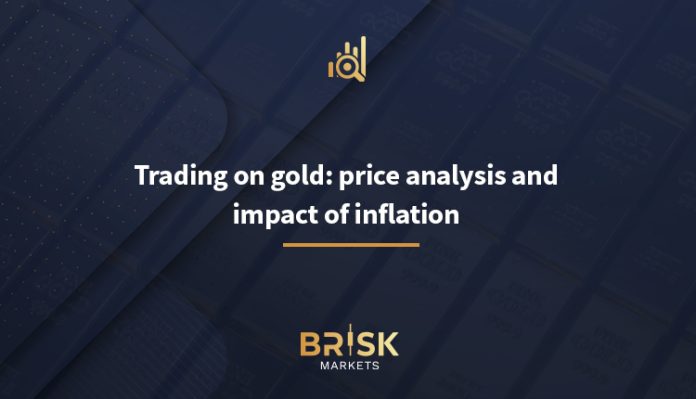At the beginning of the week, gold markets saw a relative decline as geopolitical tensions faded, and traders turned their attention to US economic data and earnings reports. Despite this, the yellow metal has continued to challenge recently, continuing to make gains despite rising yields and an advancing dollar.
Technically, gold remains overbought, but falling support levels raise the possibility of a trend reversal. It is noted that gold fell at the beginning of the week as a result of the markets’ appreciation of some geopolitical risks in the Middle East region, a development that focused attention on corporate profits, including technological giants.
It is expected that the data will return to the forefront in the coming days as a primary factor affecting the market, especially with the release of the US GDP and personal spending numbers. Strong data from the US is also expected to prevent a decline in the US dollar’s momentum.
If yields continue to rise, gold will likely come under additional pressure into the technically overbought zone, especially if investors do not recognize the risk of a US default. Gold price movement continued to rise over the past week, indicating investors’ continued preference for safe-haven assets and central bank buying, despite growing concerns about rising bond yields. Given the current economic backdrop and the possibility of interest rate hikes by the Fed, the outlook for gold in the near future remains cautiously bearish.
Investors’ preference for safe assets and central bank purchases has trumped concerns about rising bond yields, which should theoretically increase the cost of holding non-interest-bearing assets. For example, the yield on two-year US bonds is currently around 5%. By continuing to invest in gold, investors are giving up this “risk-free” return from government bonds.
Trading on gold: The impact of inflation and interest on the gold market
Recently, rising uncertainty in the Middle East played a prominent role in the impact of gold prices, as risk assets saw an additional decline on Friday, partly due to the Israeli military escalation in western Iran, which led to higher demand for gold and crude oil. However, European markets regained their balance on Friday after overnight lows, and saw a positive start to Monday’s session, as investors ignored the impact of passing strikes on Friday.
Investor attention is now turning towards inflation and interest rate data, as gold investors have not responded significantly to rising bond yields, indicating the continued use of gold as a hedge against inflation and deteriorating fiat currencies. In this context, the Federal Reserve Chairman warned that inflation has not made sufficient progress towards set targets, putting core inflation data under the microscope this week.
For its part, the dollar gained strength after the strong US CPI report published a few weeks ago, and this was reflected in a positive shift in US interest rates and interest rates in other major economies. As geopolitical tensions in the region escalate, bullish sentiment for the US dollar has increased, and the performance of personal inflation data could further support the dollar and undermine risk assets.
However, the main question remains: Will gold finally succumb to pressures from the strength of the US dollar? So far, gold remains in a consolidation phase after its significant gains, as it faces difficulty surpassing the $2,400 level.
Gold has been in a phase of consolidation after its recent big gains over the past week and a bit. It has so far struggled to achieve a daily close above the $2,400 level, which is acting as resistance against its strong bullish momentum. Aside from the prominent inverted hammer candlestick last Friday
Declining Gold Prices and Inflation Expectations: Analysis of Money Markets
Gold prices saw a decline on Monday, as investors scaled back their defensive stances taken in the wake of fears of escalating tensions in the Middle East. With tensions seemingly easing, safe-haven assets such as gold have seen a decline in demand. The reaction in the gold market was a reflection of this development, as prices witnessed a decline from their previous highs.
Trading financial derivatives involves a high risk to your capital, and you should trade with caution and with money you can afford to lose. This type of trading may not be suitable for all investors, so please ensure you understand the risks associated with it and seek independent advice if necessary.
US PCE inflation data, a key indicator of the Fed’s policy decisions, is eagerly awaited. Following the release of CPI data earlier this month, market expectations have been revised and now expect a potential interest rate cut by the Federal Reserve in late September. These expectations are reinforced by signs that despite geopolitical concerns, the Fed may postpone easing monetary policy due to persistent inflation and positive economic indicators.
As investors’ immediate concerns about tensions in the Middle East diminished, US Treasury yields rose slightly, indicating a return of interest towards riskier assets. This shift was reflected in a variety of financial instruments, with the dollar index falling slightly while maintaining strength, while European bond yields rose slightly.
Looking to the near future, the gold market remains sensitive to geopolitical developments and economic data. With key US economic indicators on the horizon, investors will be watching for signals that could influence the Federal Reserve’s policy decisions. Although there has been a decline in gold prices, fundamental geopolitical risks and economic uncertainties may lead to price fluctuations based on economic data and geopolitical news.



